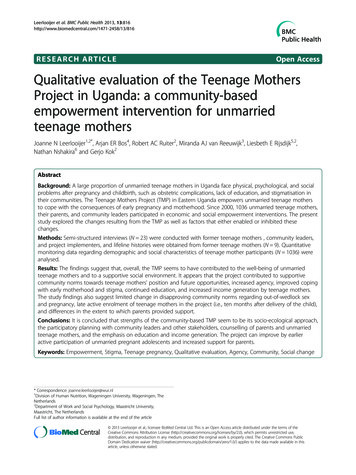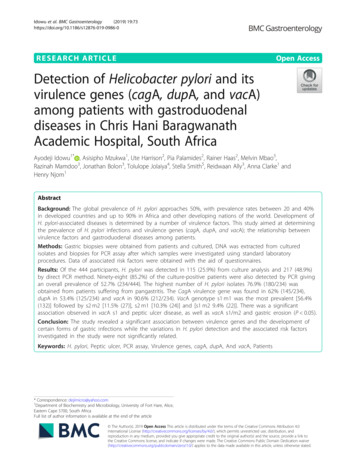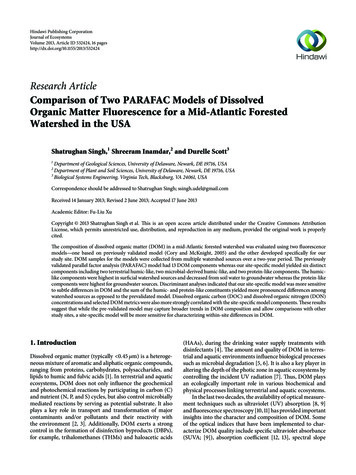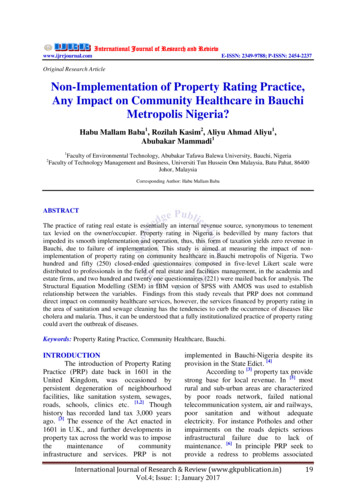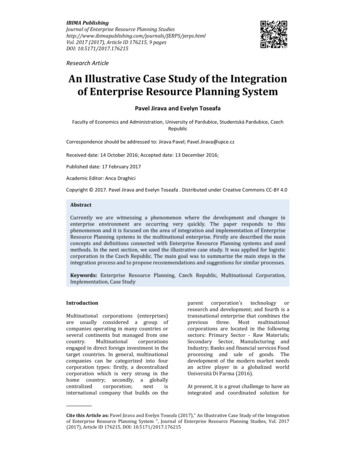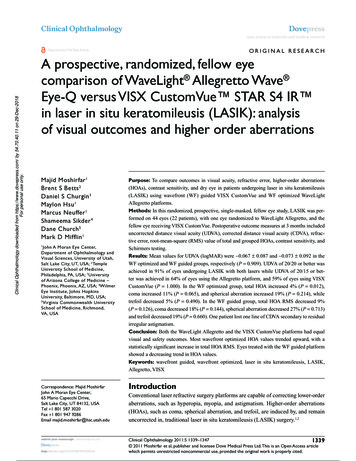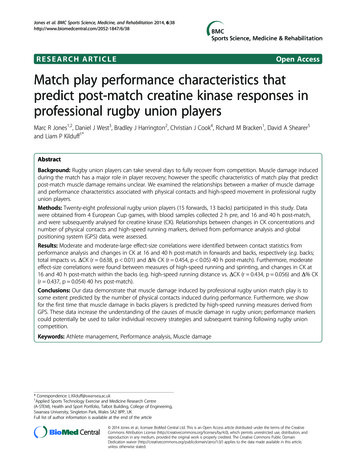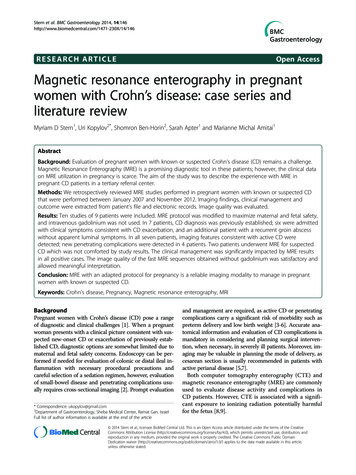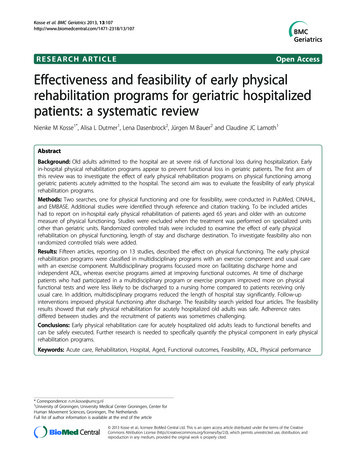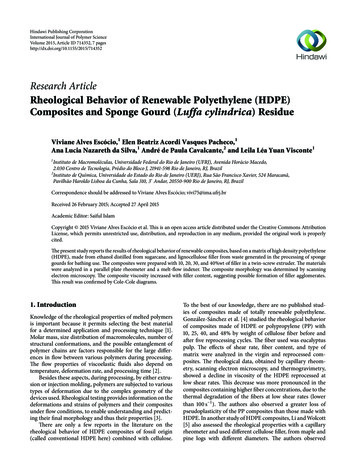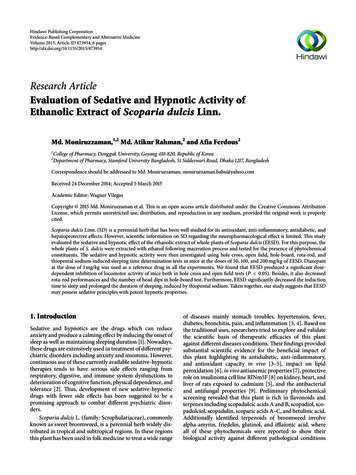
Transcription
Hindawi Publishing CorporationEvidence-Based Complementary and Alternative MedicineVolume 2015, Article ID 873954, 6 pageshttp://dx.doi.org/10.1155/2015/873954Research ArticleEvaluation of Sedative and Hypnotic Activity ofEthanolic Extract of Scoparia dulcis Linn.Md. Moniruzzaman,1,2 Md. Atikur Rahman,2 and Afia Ferdous21College of Pharmacy, Dongguk University, Goyang 410-820, Republic of KoreaDepartment of Pharmacy, Stamford University Bangladesh, 51 Siddeswari Road, Dhaka 1217, Bangladesh2Correspondence should be addressed to Md. Moniruzzaman; moniruzzaman.babu@yahoo.comReceived 24 December 2014; Accepted 5 March 2015Academic Editor: Wagner VilegasCopyright 2015 Md. Moniruzzaman et al. This is an open access article distributed under the Creative Commons AttributionLicense, which permits unrestricted use, distribution, and reproduction in any medium, provided the original work is properlycited.Scoparia dulcis Linn. (SD) is a perennial herb that has been well studied for its antioxidant, anti-inflammatory, antidiabetic, andhepatoprotective effects. However, scientific information on SD regarding the neuropharmacological effect is limited. This studyevaluated the sedative and hypnotic effect of the ethanolic extract of whole plants of Scoparia dulcis (EESD). For this purpose, thewhole plants of S. dulcis were extracted with ethanol following maceration process and tested for the presence of phytochemicalconstituents. The sedative and hypnotic activity were then investigated using hole cross, open field, hole-board, rota-rod, andthiopental sodium-induced sleeping time determination tests in mice at the doses of 50, 100, and 200 mg/kg of EESD. Diazepamat the dose of 1 mg/kg was used as a reference drug in all the experiments. We found that EESD produced a significant dosedependent inhibition of locomotor activity of mice both in hole cross and open field tests (𝑃 0.05). Besides, it also decreasedrota-rod performances and the number of head dips in hole-board test. Furthermore, EESD significantly decreased the inductiontime to sleep and prolonged the duration of sleeping, induced by thiopental sodium. Taken together, our study suggests that EESDmay possess sedative principles with potent hypnotic properties.1. IntroductionSedative and hypnotics are the drugs which can reduceanxiety and produce a calming effect by inducing the onset ofsleep as well as maintaining sleeping duration [1]. Nowadays,these drugs are extensively used in treatment of different psychiatric disorders including anxiety and insomnia. However,continuous use of these currently available sedative-hypnotictherapies tends to have serious side effects ranging fromrespiratory, digestive, and immune system dysfunctions todeterioration of cognitive function, physical dependence, andtolerance [2]. Thus, development of new sedative-hypnoticdrugs with fewer side effects has been suggested to be apromising approach to combat different psychiatric disorders.Scoparia dulcis L. (family: Scrophulariaceae), commonlyknown as sweet broomweed, is a perennial herb widely distributed in tropical and subtropical regions. In these regionsthis plant has been used in folk medicine to treat a wide rangeof diseases mainly stomach troubles, hypertension, fever,diabetes, bronchitis, pain, and inflammation [3, 4]. Based onthe traditional uses, researchers tried to explore and validatethe scientific basis of therapeutic efficacies of this plantagainst different diseases conditions. Their findings providedsubstantial scientific evidence for the beneficial impact ofthis plant highlighting its antidiabetic, anti-inflammatory,and antioxidant capacity in vivo [3–5], impact on lipidperoxidation [6], in vivo antianemic properties [7], protectiverole on insulinoma cell line RINm5F [8] on kidney, heart, andliver of rats exposed to cadmium [5], and the antibacterialand antifungal properties [9]. Preliminary phytochemicalscreening revealed that this plant is rich in flavonoids andterpenes including scopadulcic acids A and B, scopadiol, scopadulciol, scopadulin, scoparic acids A–C, and betulinic acid.Additionally identified terpenoids of broomweed involvealpha-amyrin, friedelin, glutinol, and ifflaionic acid, whereall of these phytochemicals were reported to show theirbiological activity against different pathological conditions
2[3, 10]. However, so far, there is no report demonstrating the sedative-hypnotic activity of Scoparia dulcis, whichprompted us to design the present study to evaluate therole of this plant on the central nervous system (CNS)in mice. We found that the ethanolic extract of Scopariadulcis (EESD) significantly reduced the locomotor activityand motor coordination of mice. Moreover, pretreatmentwith this extract also potentiates thiopental sodium-inducedhypnosis in mice by decreasing onset of sleep and prolongingsleeping duration. Therefore, our findings strongly supportthe sedative and hypnotic activities of EESD and suggestthat it can be useful to treat different psychiatric disordersincluding insomnia.2. Materials and Methods2.1. Plant Collection and Extraction. The whole plant of Scoparia dulcis was collected from Narsingdi, Bangladesh, in January 2012. The samples were then identified by Bushra Khan,Principal Scientific Officer, Bangladesh National Herbarium,Mirpur, Dhaka, Bangladesh. A voucher specimen (DACB:36152) has been deposited in the Herbarium for furtherreference. Powdered dried plants (250 g) were macerated with420 mL of ethanol with occasional stirring at 25 2 C for 3days. The extract was then filtered using a Buchner funneland a sterilized cotton filter. The solvent was completelyremoved by rotary evaporator and 14 g extract (Yield 5.6%)was obtained. This crude extract was then used for furtherstudies.2.2. Animals. Swiss albino mice of 20–25 g were collectedfrom Animal Resources Branch of the International Centerfor Diarrhoeal Disease Research, Bangladesh (ICDDR, B).The animals were kept in standard laboratory conditions(relative humidity 55–60%; room temperature 25 2 C;12 h light/dark cycle) and were provided with standard diet(ICDDR, B formulated) and clean water ad libitum duringacclimatization period. The animals were acclimatized to thelaboratory environment for a period of 14 days prior to performing the experiments. The animals were fasted overnightbefore the experiments. All the experimental animals weretreated following the Ethical Principles and Guidelines forScientific Experiments on Animals (1995) formulated by TheSwiss Academy of Medical Sciences and the Swiss Academyof Sciences. All experimental protocols were approved by theInstitutional Ethics Committee (SUB/IAEC/12.01).2.3. Drugs and Treatments. The animals were divided intofive groups containing 5–7 animals each for control, standard,and test sample for every experiment. EESD was dissolvedin DMSO and orally administered to the test animals 30 minbefore the experiments at the doses of 50, 100, and 200 mg/kgbody weight. On the other hand, the standard drug diazepam(1 mg/kg) employed in all tests was administered intraperitoneally (i.p.) 15 min before the experiments where thiopentalsodium (20 mg/kg) in sleeping time measurement test wasadministered 15 min after treatment with diazepam and30 min of vehicle (DMSO) or EESD. The animals in controlEvidence-Based Complementary and Alternative Medicinegroup received vehicle orally at the dose of 0.1 mL/mouse30 min before the experiments.2.4. Phytochemical Screening. The ethanolic extract of Scoparia dulcis was qualitatively investigated for the presence ofalkaloids, flavonoids, tannins, saponins, and gum accordingto the standard procedures [11].2.5. Acute Toxicity Test. The mice were divided into controland three test groups each containing five animals. EESD wasadministered to the animals orally at doses of 1000, 2000, and3000 mg/kg. The mice were given access to food and water adlibitum and all animals were observed for allergic symptomsand mortality for the next 72 h [12].2.6. Hole Cross Test. For this experiment, a cage was usedhaving a size of 30 20 14 cm with a fixed partition inthe middle having a hole of 3 cm diameter [13]. The animalswere treated with either vehicle or drug or EESD and allowedto cross the hole from one chamber to another. Mice wereobserver for 3 min and the number of passages was recordedat 30, 60, 90, and 120 min following the treatments.2.7. Open Field Test. This method was carried out as described by Gupta et al. [14]. The open field apparatus consistedof a wooden field of half square meter with a series of squaresalternatively painted in black and white. It had a wall of 50 cmheight and was placed in a dimly lit room. Mice were treatedwith vehicle, extract, or diazepam and were placed in themiddle of the open field. Then the number of squares visitedby the animals was counted for 3 minutes at 30, 60, 90, and120 min after the treatments.2.8. Hole-Board Test. The hole-board test was performedaccording to the previously described method by Ozturk etal. [15], with slight modifications. For this test, we used aflat platform of 60 cm 30 cm in diameter with 16 evenlyspaced holes. In brief, thirty minutes after vehicle or EESDand 15 min after diazepam administration, each animal wasallowed to move on the platform and the number of head dipsinto the holes was counted for 5 min.2.9. Test for Motor Coordination (Rota-Rod Test) in Mice.This test was performed using a horizontal rotation rod (UgoBasile, Varese, Italy) set at a rate of 20 revolutions per min.Mice that were able to remain on the rod longer than 180 swere selected and divided into desired groups. Thirty minutesafter the vehicle or EESD administration, each mouse wasplaced on the rod for 180 s where diazepam was given 15 minbefore the experiment [16]. Then the falling time from therotating rod was recorded for each mouse.2.10. Thiopental Sodium-Induced Sleeping Time Determination. Thiopental sodium-induced sleeping time was evaluated according to the previously described method [17].Thirty min after vehicle or EESD and 15 min after diazepamtreatment, thiopental sodium (TS) was administered to each
Evidence-Based Complementary and Alternative Medicine3Table 1: Effect of EESD on hole cross test.TreatmentDose (mg/kg)ControlDiazepamEESDEESDEESD0.1 mL/mouse150100200Pretreatment19 1.5821.2 1.6318.6 1.6920.4 1.0821 0.84Number of holes crossed (% of inhibition)30 min60 min90 min17.60 0.7515.6 0.9313.4 0.513.2 0.37 (79.49)2.0 0.45 (85.07)5.2 1.16 (70.45) 10.2 1.20 (34.62)7.2 1.16 (46.27)12.6 1.54 (28.41) 7.8 1.02 (50.00)3.6 0.81 (73.13)8.80 0.49 (50.00)2.0 0.71 (87.18)1.6 0.4 (88.06)6.0 0.84 (65.91)120 min12.4 0.512.2 0.74 (82.26)4.2 0.97 (66.13)3.2 0.86 (74.19)1.2 0.37 (90.32)Values are presented as the Mean SEM (𝑛 5). EESD ethanolic extract of Scoparia dulcis; 𝑃 0.05 compared with the control group (two-way ANOVAfollowed by Bonferroni’s test).animal intraperitoneally at the dose of 20 mg/kg. Then theanimals were observed for the time to lose their rightingreflex, immediately after thiopental sodium injection (latentperiod) and the duration of sleep (time between the loss andrecovery of reflex) induced by TS.2.11. Statistical Analysis. The results are presented as Mean SEM. The statistical analysis was performed using one-wayanalysis of variance (ANOVA) followed by Dunnett’s post hoctest, except for the hole cross test and open field test. Forthese tests, two-way ANOVA followed by Bonferroni’s posthoc tests was adopted. All statistical analysis was performedusing SPSS 11.5 software.3. Results and DiscussionsThe present study investigated the putative CNS effect ofan ethanolic extract of whole plants of S. dulcis. The resultsshowed that EESD exerts sedative and hypnotic effect on theCNS. Moreover, it was also found that acute oral administration of EESD at the doses of 1000, 2000, and 3000 mg/kgdid not produce any allergic manifestations or mortalityduring the observation period of 72 h after administration.Therefore, it is conceivable that EESD may not be toxic at ourexperimental doses up to 3000 mg/kg.We started our investigation for the sedative effects ofEESD by recording spontaneous locomotor activity of mice inhole cross and open field tests. In these tests, any agents withsedative properties will produce a decrease in the numberof movements, interpreted as a decrease in curiosity of thenew environment [13, 18]. Our result demonstrated thatthe oral administration of EESD in all doses (50, 100, and200 mg/kg) caused a marked reduction in number of holecrossed (Table 1). The suppressive effect was found at 30 minand continued up to 120 min after administration of EESD.Also, similar types of responses were observed in the openfield test. EESD at all tested doses produced significant (𝑃 0.05) inhibition of locomotion that was maintained from30 min to 120 min of observation period (Table 2). This abilityof EESD to suppress the locomotor activity suggests that theextract is endowed with central nervous system depressantactivity.Another important observation was achieved in the holeboard test. This test is well-established as a means to assaypotential anxiolytic and sedative effects of any agents byobserving the exploratory behavior in rodents. This experiment is advantageous due to its methodological simplicityand several behavioral responses of an animal can be readilyobserved and quantified when exposed to an unfamiliarenvironment. It was found that the head-dipping behaviorof the animals is directly related to their emotional state[19]. Based on this observation, it was suggested that theexpression of an anxiolytic state in animals might be reflectedby an increase in head-dipping behavior [19], while a decreasein the number of head dips was found to be correlatedwith the depressant effect [20, 21]. Our results revealed thatthe ethanolic extract of S. dulcis caused a dose-dependentreduction
paria dulcis was qualitatively investigated for the presence of alkaloids, avonoids, tannins, saponins, and gum according tothestandardprocedures[ ]. Acute Toxicity Test. e mice were divided into control andthreetestgroupseachcontaining veanimals.EESDwas administeredtotheanimalsorallyatdosesof, ,and mg/kg.emiceweregivenaccesstofoodandwater ad
